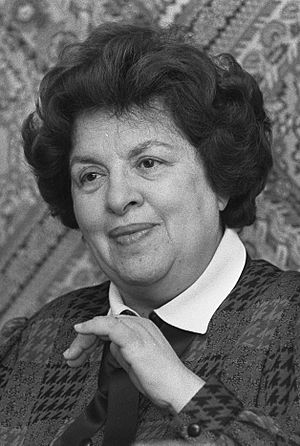Maria de Lourdes Pintasilgo facts for kids
Quick facts for kids
Maria de Lourdes Pintasilgo
|
|
|---|---|

Pintasilgo in 1986
|
|
| Prime Minister of Portugal | |
| In office 1 August 1979 – 3 January 1980 |
|
| President | António Ramalho Eanes |
| Preceded by | Carlos Mota Pinto |
| Succeeded by | Francisco de Sá Carneiro |
| Minister of Social Affairs | |
| In office 17 July 1974 – 26 March 1975 |
|
| Prime Minister | Vasco Gonçalves |
| Preceded by | Mário Murteira |
| Succeeded by | Jorge Sá Borges |
| Personal details | |
| Born | 18 January 1930 Abrantes, Portugal |
| Died | 10 July 2004 (aged 74) Lisbon, Portugal |
| Political party | Socialist Party |
| Alma mater | University of Lisbon |
| Signature | |
Maria de Lourdes Ruivo da Silva de Matos Pintasilgo (born January 18, 1930 – died July 10, 2004) was an important Portuguese engineer and politician. She made history as the first and only woman to become Prime Minister of Portugal. She was also the second woman to be a prime minister in Western Europe, after Margaret Thatcher.
Contents
Early Life and Education
Maria de Lourdes Pintasilgo was born in 1930 into a middle-class family. Her father, Jaime de Matos Pintasilgo, worked in the wool business. Her mother was Amélia do Carmo Ruivo da Silva.
When she was seven, Maria went to a secondary school in Lisbon. She was a very good student. She joined the Mocidade Portuguesa, a youth movement, and later Acção Católica (Catholic Action). While studying industrial chemical engineering at the Instituto Superior Técnico, she led the Catholic women's student movement.
Her Career Journey
After graduating in 1953 at age 23, Maria de Lourdes Pintasilgo started her career. She first joined a scholarship program with the National Nuclear Energy Board. Then, she worked for a large Portuguese company called Companhia União Fabril (CUF). This company owned many businesses, including cement plants.
By 1954, she was the chief engineer of the studies and projects division. She quickly moved up to project director. In this role, she managed the company's information center and technical journals. She worked there for seven years, until 1960.
Maria had strong connections with the Roman Catholic Church. From 1952 to 1956, she was president of a women's group at Lisbon's Catholic University of Portugal. In 1956, she became the international president of Pax Romana, a Catholic student movement. In 1961, she joined the Grail, an international Catholic women's movement. She later helped establish it in Portugal.
By 1965, she was the Grail's international vice-president. The Vatican also chose her to be a link between the Roman Catholic Church and the World Council of Churches. After leaving CUF, she worked for the government from 1960 to 1969. She ran Portugal's program for development and social change. In 1970, she led government groups focused on women's issues. She was also part of Portugal's team at the United Nations in 1971–72.
After a big change in Portugal in 1974, she became the secretary of state for social welfare. By early 1975, she was the Minister of Social Affairs. In 1975, Pintasilgo became Portugal's first Ambassador to UNESCO. UNESCO is the United Nations Educational, Scientific and Cultural Organization.
Becoming Prime Minister
In 1979, the President of Portugal, General António Ramalho Eanes, asked Maria de Lourdes Pintasilgo to become prime minister. She took office on August 1, 1979, for a three-month period.
During her time as prime minister, she worked to improve Portugal's social welfare system. She made social security available to everyone. She also improved healthcare, education, and laws about work in Portugal.
In 1986, Maria de Lourdes Pintasilgo became the first woman to run for president in Portugal. She ran as an independent candidate and received 7% of the votes. The next year, she was elected to the European Parliament as a member of the Socialist Party. She served there until 1989.
From 1992, she led the Independent Commission for Population and Quality of Life (ICPQL). This group was supported by the United Nations and other organizations. Its goal was to make suggestions to improve the quality of life for people around the world. In 1994, she said, "The ultimate goal of Population and Development is to accord an improved quality of life to the people of the world. Not only to count people but to ensure that people count in Development." The commission's report was published in 1996.
Maria de Lourdes Pintasilgo passed away at her home in Lisbon on July 10, 2004, at the age of 74. She was buried in Prazeres Cemetery in Lisbon.
Maria de Lourdes Pintasilgo Award
Maria de Lourdes Pintasilgo was a former student at the Instituto Superior Técnico (IST). This is a very famous engineering school in Portugal. Since 2016, IST gives out the Maria de Lourdes Pintasilgo Award.
This award celebrates two women who graduated from IST each year. It helps to encourage more girls and women in engineering. It also recognizes the important role women play in all areas of engineering.
See also
In Spanish: Maria de Lourdes Pintasilgo para niños

